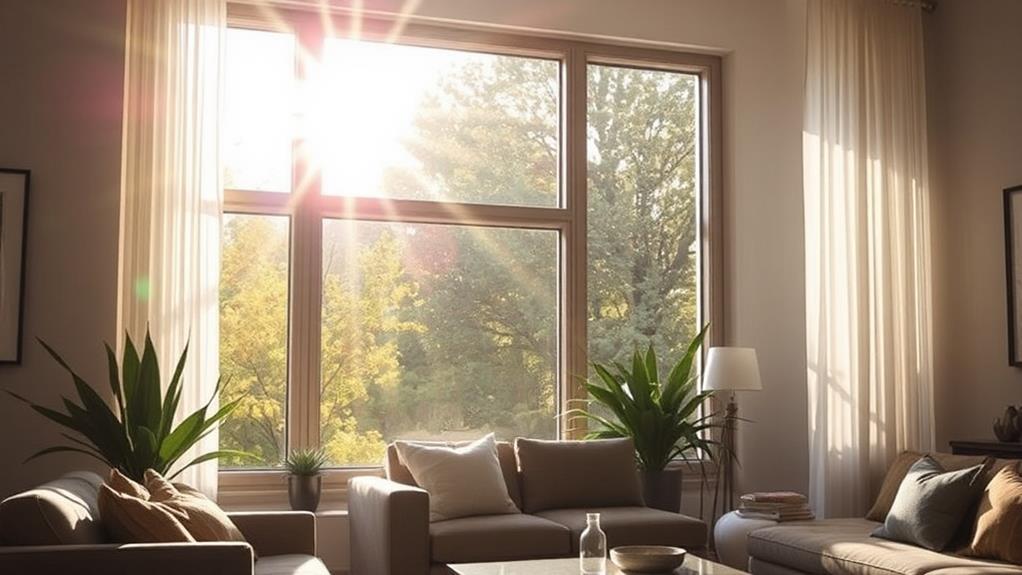Low-E glass in your windows can transform your home's energy efficiency and comfort. You'll enjoy significant savings on heating and cooling costs, as the specialized coating reflects heat to keep your home cooler in summer and warmer in winter. It also blocks up to 99% of harmful UV rays, protecting your furniture and flooring from fading. You'll experience enhanced year-round comfort with reduced glare and more consistent indoor temperatures. Low-E glass even helps dampen external noise, creating a more peaceful living environment. While the initial cost may be higher, the long-term benefits in energy savings, UV protection, and increased property value make it a smart investment. Discover how this innovative technology can elevate your home's performance and comfort.
Understanding Low-E Glass Technology
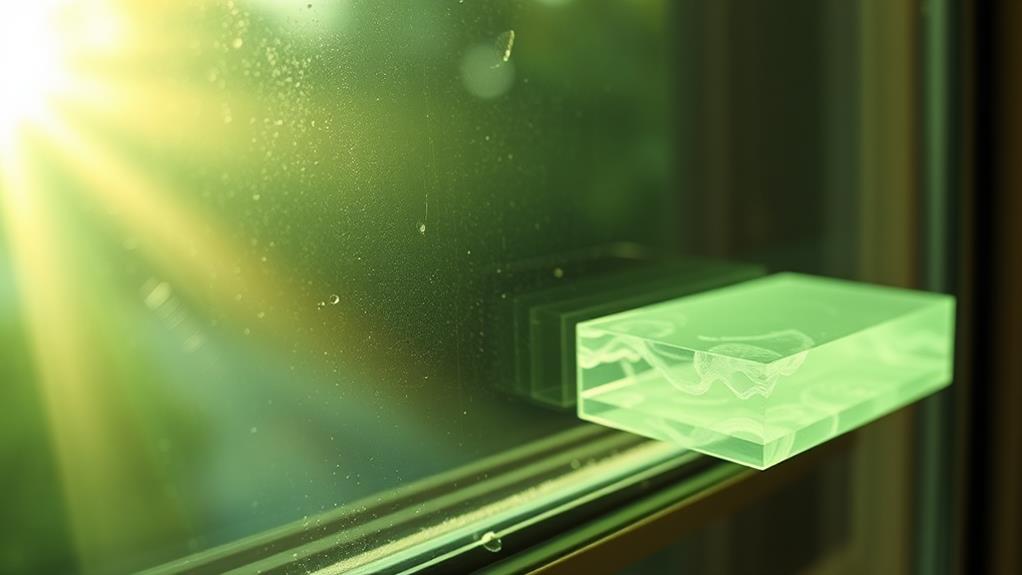
When you hear about Low-E glass, you might wonder what the "E" stands for. It's short for "low emissivity," which refers to the glass's ability to minimize the amount of ultraviolet and infrared light passing through it while allowing visible light to enter.
Low-E glass is created by applying a microscopically thin, transparent coating to the glass surface. This coating is typically made of metal oxides, such as silver, tin, or zinc. The coating works by reflecting heat back to its source, whether that's inside your home during winter or outside during summer.
There are two main types of Low-E coatings: hard-coat and soft-coat. Hard-coat Low-E is applied during the glass manufacturing process and is more durable but less efficient. Soft-coat Low-E is applied after the glass is made and offers better performance but requires more careful handling.
Low-E technology can be further enhanced by using multiple panes of glass with Low-E coatings and filling the spaces between them with inert gases like argon or krypton. This combination significantly improves the window's insulating properties, making your home more energy-efficient year-round.
Energy Savings and Efficiency
Homeowners rejoice! Low-E glass can significantly reduce your energy bills and improve your home's overall efficiency. By reflecting heat back into your home during winter and keeping it out during summer, you'll notice a substantial decrease in your heating and cooling costs.
Low-E windows minimize heat transfer, reducing the workload on your HVAC system. This means your air conditioner and heater won't have to work as hard to maintain a comfortable temperature, leading to lower energy consumption and extended equipment life. You'll also experience fewer drafts and cold spots near windows, creating a more consistent indoor climate throughout your home.
The energy savings from Low-E glass can be substantial. Depending on your climate and home's design, you could see a reduction of up to 30% in your annual energy costs. Over time, these savings can offset the initial investment in Low-E windows. Additionally, many utility companies and government programs offer rebates or incentives for energy-efficient upgrades, further enhancing your cost savings. By choosing Low-E glass, you're not only reducing your carbon footprint but also making a smart financial decision for your home's long-term value and comfort.
UV Protection for Interiors
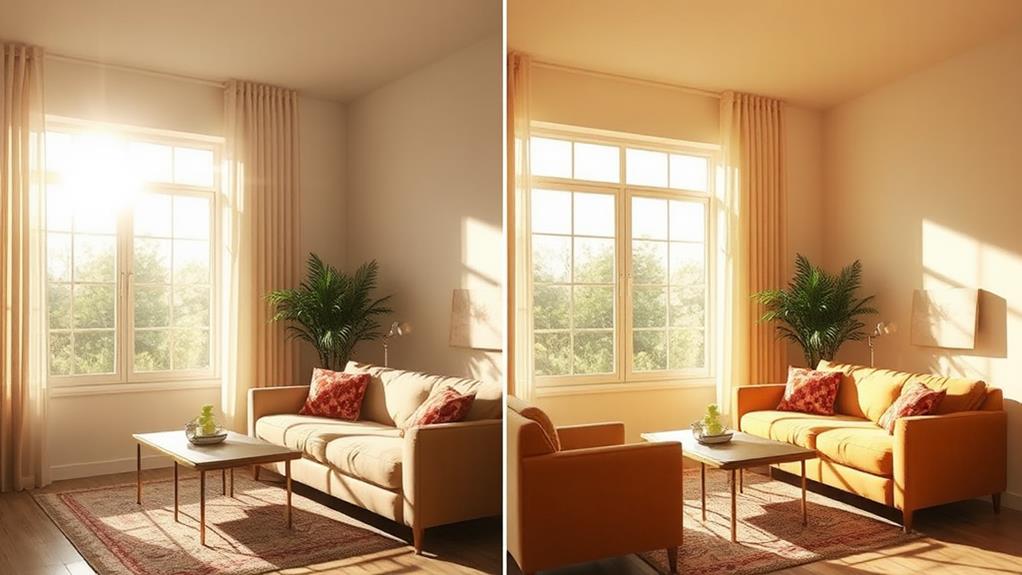
Another significant advantage of Low-E glass is its ability to protect your home's interior from harmful UV rays. UV radiation can cause fading and damage to your furniture, flooring, artwork, and other valuable items inside your home. Low-E glass acts as a powerful shield, blocking up to 99% of these damaging rays.
When you install Low-E windows, you're essentially creating a protective barrier for your belongings. This means your expensive hardwood floors won't lose their luster as quickly, and your favorite family photos won't fade over time. Your upholstery will maintain its vibrant colors longer, and your cherished paintings will be better preserved.
The UV-blocking properties of Low-E glass don't just protect your possessions; they also help safeguard your health. By reducing your exposure to UV radiation inside your home, you're lowering your risk of skin damage and potential long-term health issues associated with excessive UV exposure.
You'll find that with Low-E glass, you can enjoy natural light without worrying about its harmful effects. This allows you to keep your curtains open and bask in the sunlight while still protecting your interiors and your family's well-being.
Enhanced Comfort Year-Round
Low-E glass doesn't just protect your interiors; it also significantly improves your home's comfort throughout the year. During hot summer months, it reflects the sun's heat, keeping your indoor spaces cooler and reducing the strain on your air conditioning system. This means you'll enjoy a more consistent temperature without cranking up the AC, leading to lower energy bills.
In winter, Low-E glass works in reverse, reflecting heat back into your home. This insulating effect helps maintain warmth and reduces cold spots near windows, creating a cozier living environment. You'll find yourself relying less on your heating system, further cutting energy costs.
Beyond temperature control, Low-E glass reduces glare from sunlight, making it easier to watch TV, work on computers, or read without squinting or adjusting blinds. It also minimizes fading of furniture and flooring by blocking harmful UV rays, preserving your home's interior for longer.
Noise Reduction Properties
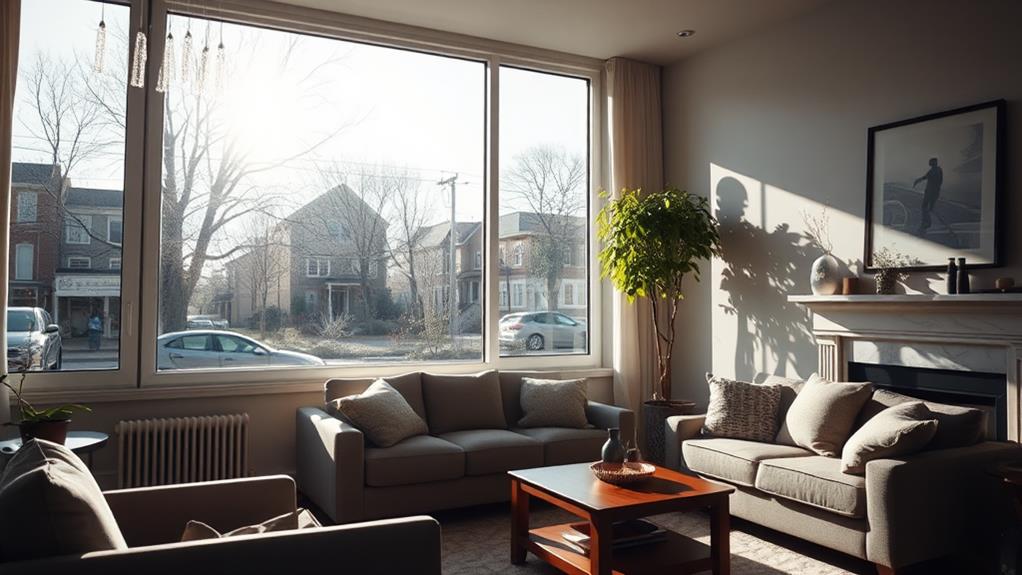
Tranquility in urban living can be enhanced with Low-E glass windows. While primarily known for their thermal insulation properties, Low-E glass also offers significant noise reduction benefits.
The multiple layers of glass and insulating gas used in Low-E windows create a barrier that dampens sound waves, reducing the amount of external noise that enters your home.
You'll notice a considerable difference in noise levels, especially if you live near busy streets, airports, or other noisy environments. Low-E glass can reduce sound transmission by up to 20-30% compared to single-pane windows. This means you'll experience fewer disturbances from traffic, construction, or noisy neighbors.
The noise reduction properties of Low-E glass aren't just about blocking out unwanted sounds; they also help maintain your privacy by preventing internal noise from escaping. This is particularly beneficial if you work from home or enjoy listening to music without disturbing others.
Condensation Control
While many homeowners struggle with foggy windows, Low-E glass offers an effective solution for condensation control. This innovative glass technology helps regulate temperature differences between your home's interior and exterior, reducing the likelihood of condensation forming on your windows.
Low-E glass works by reflecting heat back into your home during colder months and keeping it out during warmer periods. This consistent temperature control minimizes the occurrence of cold spots on your windows' interior surfaces, which are prime areas for condensation to form. By maintaining a more uniform temperature across the glass, you'll notice significantly less fog and moisture buildup.
The benefits of condensation control extend beyond just clearer views. You'll also reduce the risk of mold and mildew growth around your window frames, protecting your home's structural integrity and indoor air quality. Additionally, you'll prevent water damage to nearby walls, windowsills, and flooring caused by excessive moisture.
Environmental Impact
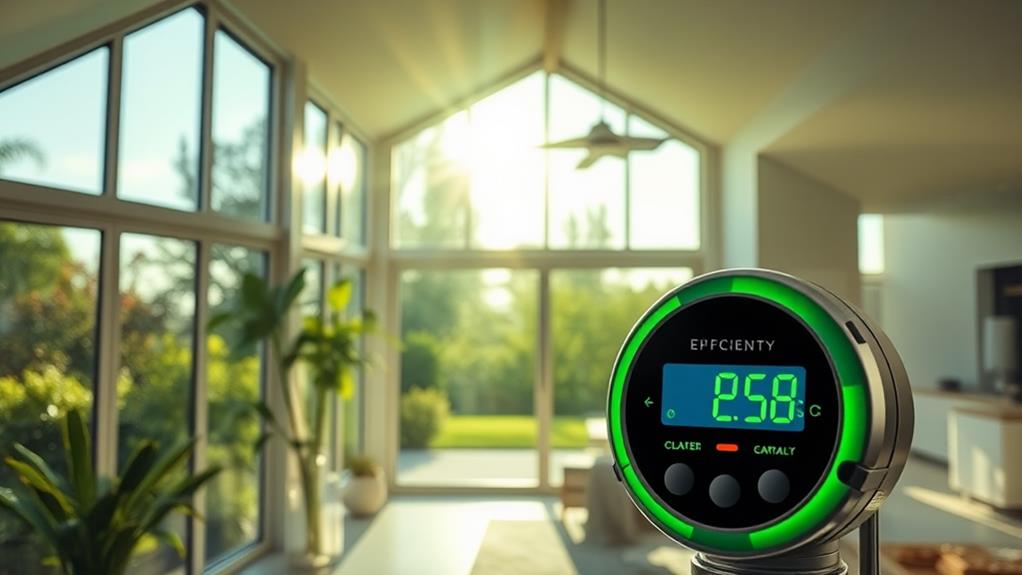
Beyond its impact on your home's comfort and energy efficiency, Low-E glass plays a significant role in reducing your environmental footprint. By minimizing heat transfer, these windows help decrease your reliance on heating and cooling systems, leading to lower energy consumption. This reduction in energy use translates to fewer greenhouse gas emissions from power plants, contributing to the fight against climate change.
Low-E glass also helps protect your furniture, flooring, and artwork from harmful UV rays. This preservation effect means you'll need to replace these items less frequently, reducing waste and conserving resources. Additionally, the improved insulation properties of Low-E glass can lead to smaller HVAC systems in new constructions, further decreasing material use and environmental impact.
The manufacturing process of Low-E glass has become increasingly eco-friendly, with many producers adopting sustainable practices and recycling programs. By choosing Low-E windows, you're supporting these green initiatives and promoting responsible resource management. Moreover, the long lifespan of Low-E windows means fewer replacements over time, reducing the overall environmental impact associated with window production and disposal.
Cost-Benefit Analysis
For many homeowners, the decision to invest in Low-E glass windows comes down to a cost-benefit analysis. While the initial cost of Low-E windows is higher than standard glass, you'll find significant savings in the long run.
On average, you can expect to pay 10-15% more for Low-E glass, but the energy savings can offset this expense within a few years.
You'll see immediate reductions in your heating and cooling costs, as Low-E glass keeps your home warmer in winter and cooler in summer. This improved energy efficiency can lead to savings of up to 30% on your utility bills. Additionally, Low-E glass protects your furniture, flooring, and artwork from UV damage, potentially saving you money on replacements and repairs.
The durability of Low-E glass also means you won't need to replace your windows as frequently, further increasing your long-term savings. When considering resale value, homes with energy-efficient windows are often more attractive to buyers, potentially increasing your property's worth. Overall, the cost-benefit analysis typically favors Low-E glass, making it a smart investment for most homeowners.
Installation and Maintenance
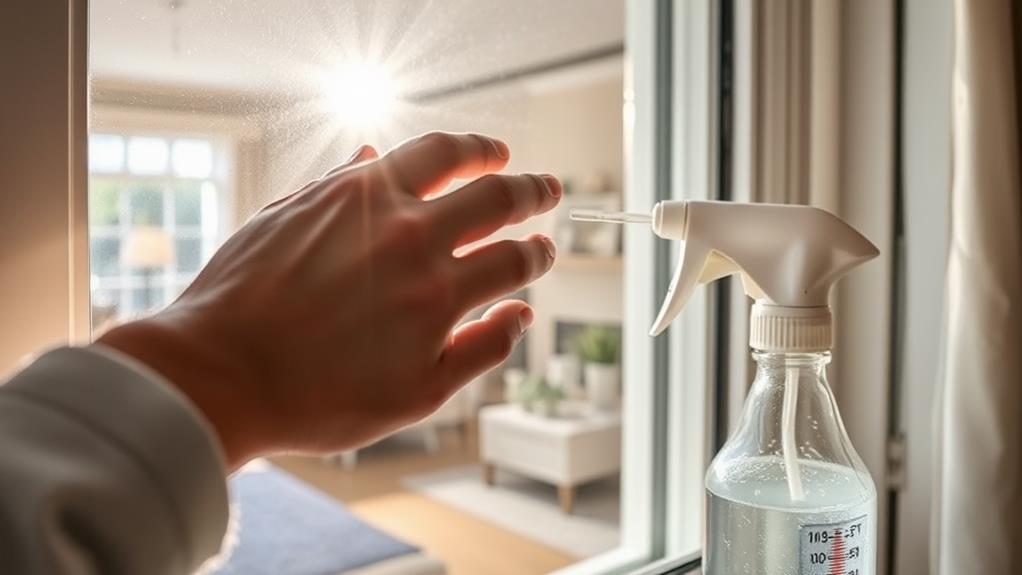
When it comes to installation, Low-E glass windows aren't much different from standard windows. You can have them professionally installed or, if you're handy, tackle the project yourself. The process involves removing old windows, preparing the opening, and securing the new Low-E glass windows in place. Make sure to follow manufacturer guidelines and local building codes during installation.
Maintenance for Low-E glass is straightforward. You'll clean these windows just like regular ones, using a mild soap solution and a soft cloth or sponge. Avoid abrasive cleaners or materials that could scratch the surface. It's important to regularly check the seals and weatherstripping around your Low-E windows to ensure they remain energy-efficient.
While Low-E coatings are durable, they can be damaged by harsh chemicals or excessive force. If you notice any chips, cracks, or peeling in the coating, it's best to consult a professional for repair or replacement. With proper care, your Low-E glass windows will maintain their energy-saving properties and clarity for many years, continuing to provide you with improved comfort and reduced energy costs.
Aesthetic Considerations
Appearance matters when it comes to your home's windows. Low-E glass offers several aesthetic advantages that can enhance your home's overall look. Unlike some energy-efficient window options, Low-E glass doesn't compromise on clarity or visibility. You'll still enjoy unobstructed views of the outdoors without any noticeable tinting or coloration.
Low-E coatings are microscopically thin and virtually invisible to the naked eye. This means your windows will maintain their original appearance, whether you prefer a classic or modern style. The coating doesn't alter the color of light passing through, so your interior spaces will retain their natural lighting ambiance.
Another aesthetic benefit is the reduction of condensation on your windows. Low-E glass helps maintain a more consistent surface temperature, reducing the likelihood of fog or water droplets forming on the glass. This keeps your windows looking clean and clear, even in humid conditions.
If you're considering window replacements, you'll find Low-E glass available in various frame materials and styles. This versatility allows you to choose windows that perfectly complement your home's architecture while reaping the energy-saving benefits of Low-E technology.
Conclusion
As you gaze through your new low-E windows, you're not just seeing the world outside; you're peering into a future of efficiency and comfort. Like a silent guardian, this invisible shield protects your home from nature's extremes. It's more than glass; it's a crystal ball showing lower energy bills and a greener tomorrow. Embrace this window of opportunity – your home's transformation awaits, and the view has never been clearer.
